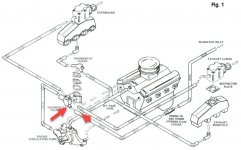Impeller housing is new. Thermostat is new. Would a chemical flush like barnacle buster make a difference? I’ve flushed all heat exchangers with water, looking for impeller peices and they appear OK. I have a closed system.
I'm not familiar w. closed cooling systems; never owned one. Although I *should*.
But a boat mechanic once showed me a trick that might be useful to you especially since you have two engines and one operates well. You need to find exactly where the raw water enters the cooling system. I've attached a schematic and indicated where it would be on the schematic, but you need to find where that would be on *your* system. You then detach the hose at that point and run each engine for an *exact* amount of time, I'd say 30 seconds to 1 minute. You empty that hose into a bucket. You need to be careful here because there are a bunch of belts and pulleys that may really make you regret buying a boat. After you do this with both engines, you compare the volumes. The amount coming out of those hoses should be just more than a regular garden hose. If the amount that comes out of the bad engine is significantly less than the good engine, then that's a pretty good sign that you have a problem *downstream* from that point. Since you have a new housing and impeller and you cleared the system previously then as Scott Danforth indicated, Bravoitis might be a culprit.
If both volumes are the same, then I can't really help diagnose a closed system but at least you can be confident you've begun to isolate the issue as upstream from that point.




















